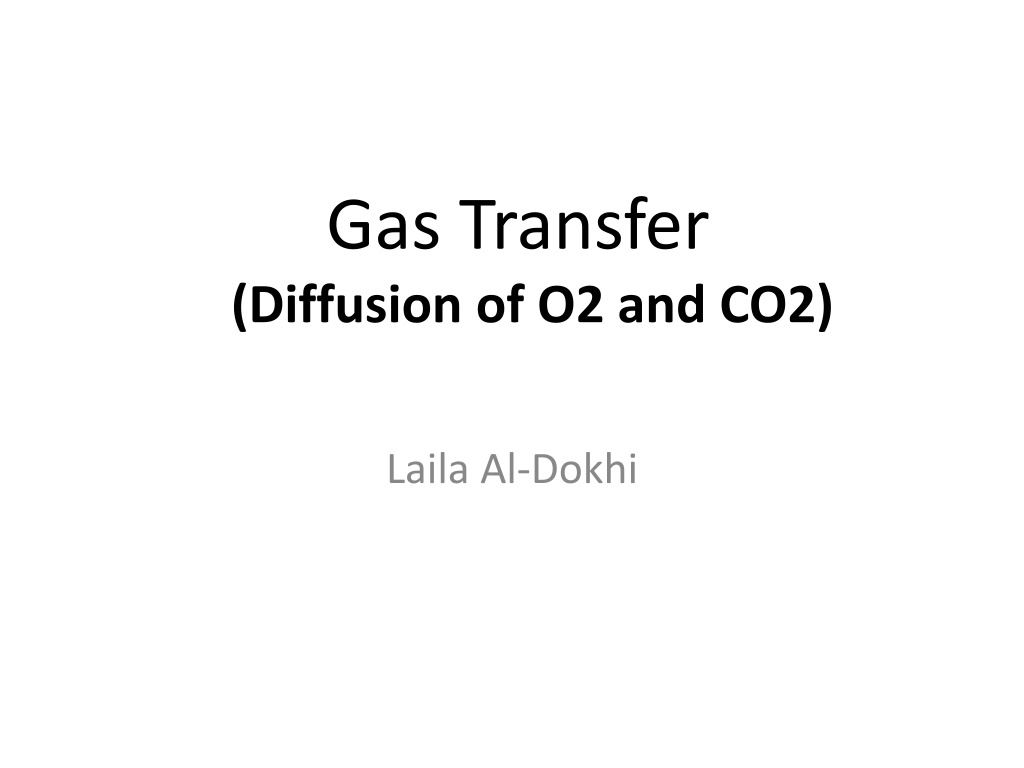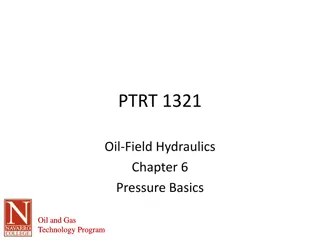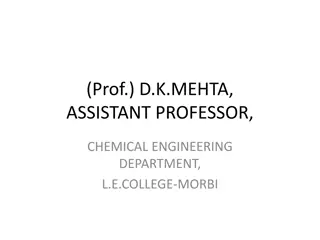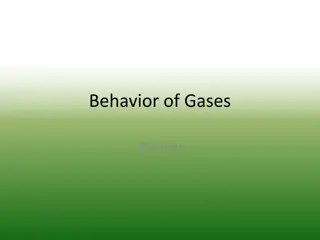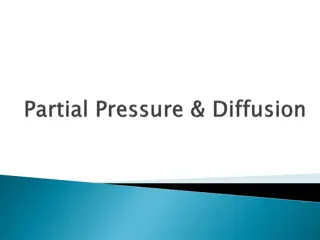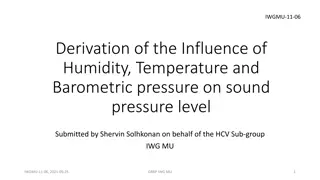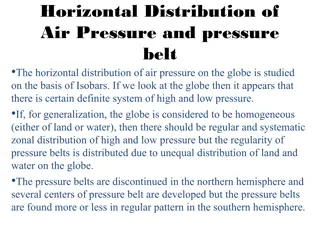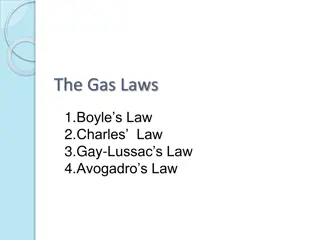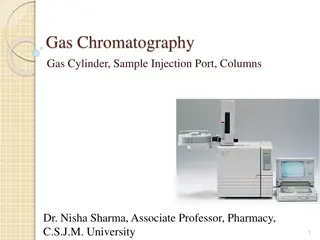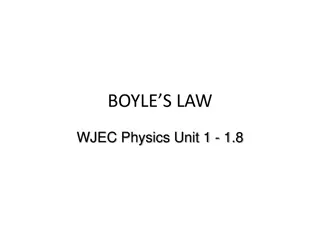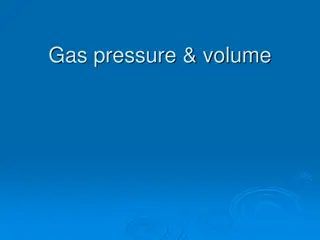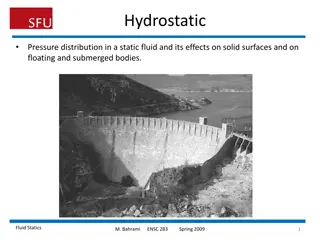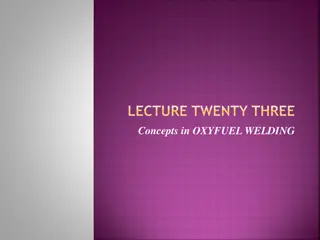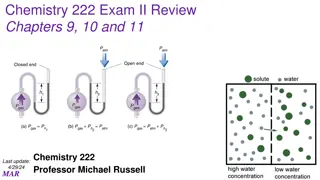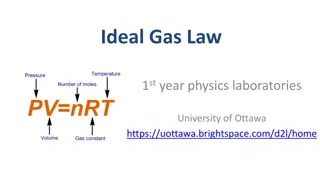Gas Transfer and Laws of Partial Pressure
Dive into the intricacies of gas transfer through the respiratory membrane, understanding Dalton's Law of Partial Pressures and Henry's Law. Explore the factors affecting gas diffusion and the partial pressures of gases within mixtures. Gain insight into the crucial mechanisms governing gas exchange within the body.
Download Presentation

Please find below an Image/Link to download the presentation.
The content on the website is provided AS IS for your information and personal use only. It may not be sold, licensed, or shared on other websites without obtaining consent from the author. Download presentation by click this link. If you encounter any issues during the download, it is possible that the publisher has removed the file from their server.
E N D
Presentation Transcript
Gas Transfer (Diffusion of O2 and CO2) Laila Al-Dokhi
objectives: 1-Define partial pressure of a gas. 2-Understand that the pressure exerted by each gas in a mixtureof gases is independent of the pressure exerted by the other gases (Dalton's Law) 3-Understand that gases in a liquid diffuse from higher partial pressure to lower partial pressure (Henry s Law) 4-Describe the factors that determine the concentration of a gas in a liquid. 5-Describe the components of the alveolar-capillary membrane (i.e., what does a molecule of gas pass through). 6-Knew the various factors determining gas transfer: - Surface area, thickness, partial pressure difference, and diffusion coefficient of gas 7-State the partial pressures of oxygen and carbon dioxide in the atmosphere, alveolar gas, at the end of the pulmonary capillary, in systemic capillaries, and at the beginning of a pulmonary capillary.
Gas exchange through the respiratory membrane
Partial pressure of gases (in a mixture) The pressure of gas is caused by the constant kinetic movement of gas molecules against the surface. In respiratory physiology, there is a mixture of gases mainly of O2, N2, and CO2. The rate of diffusion of each of these gases is directly proportional with the partial pressure of the gas. Pressure of gases dissolved in water and tissue: The pressure of gases dissolved in fluid is similar to their pressure in the gaseous phase and they exert their own individual partial pressure.
2-Dalton's Law of Partial Pressures It states that the total pressure exerted by a mixture of gases is the sum of partial pressure of each individual gas present. Ptotal = P1 + P2 + P3 + . .
3-Henry's Law Gas solubility is proportional to the gas partial pressure. If the temperature stays constant increasing the pressure will increase the amount of dissolved gas. Low pressure equilibrium Low concentration Double the pressure equilibrium Double the concentration
4-Factors that affect the rate of gas diffusion through the respiratory membrane D d x MW D: diffusion rate 1. P: Partial pressure differences 2. A: Surface area for gas exchange 3. S: Solubility of gas 4. d: Diffusion distance 5. MW: Molecular weight P x A x S
4-Factors that affect the rate of gas diffusion through the respiratory membrane The diffusion rate of the specific gas: Diffusion coefficient for the transfer of each gas through the respiratory membrane depends on: Directly on its solubility (S) through the membrane Inversely on the square root of its molecular weight (MW). CO2 diffuses 20 times as rapidly as O2.
4-Factors that affect the rate of gas diffusion through the respiratory membrane P: Partial pressure differences The pressure difference between the two sides of the membrane (between the alveoli and the blood). When the pressure of the gas in the alveoli is greater than the pressure of the gas in the blood as for O2, net diffusion from the alveoli into the blood occurs. When the pressure of the gas in the blood is greater than the pressure in the alveoli as for CO2, net diffusion from the blood into the alveoli occurs.
4-Factors that affect the rate of gas diffusion through the respiratory membrane Surface area of the membrane (A). Removal of an entire lung decreases the surface area to half normal. In emphysema with dissolution of the alveolar wall to 5-folds because of loss of the alveolar walls. The thickness of the respiratory membrane (d:Diffusion distance) thickness of the respiratory membrane e.g., edema of diffusion. The thickness of the respiratory membrane is inversely proportional to the rate of diffusion through the membrane. S.A. rate
Epithelial basement membrane Capillary basement membrane Interstitial space Capillary endothelium Alveolar epithelium Red blood cell Fluid and surfactant layer Alveolus Capillary Diffusion O2 Diffusion CO2
Composition of alveolar air and its relation to atmospheric air: Alveolar air is partially replaced by atmospheric air with each breath. O2 is constantly absorbed from the alveolar air. CO2 constantly diffuses from the pulmonary blood into the alveoli. The dry atmospheric air enters the respiratory passage is humidified before it reaches the alveoli.
Partial pressures of respiratory gases as they enter and leave the lungs (at sea level) N2 O2 CO2 H2O 597.0 (78.62%) Atmospheric Air* (mmHg) 159.0 (20.84%) 0.3 (0.04%) 3.7 (0.50%) 563.4 (74.09%) Humidified Air (mmHg) 149.3 (19.67%) 0.3 (0.04%) 47.0 (6.20%) 569.0 (74.9%) Alveolar Air (mmHg) 104.0 (13.6%) 40.0 (5.3%) 47.0 (6.2%) 566.0 (74.5%) Expired Air (mmHg) 120.0 (15.7%) 27.0 (3.6%) 47.0 (6.2%)
Partial Pressure of O2 and CO2 Oxygen concentration in the atmosphere is 21% So PO2 in atmosphere =760mmHg x 21%=160 mmHg. This mixes with old air already present in alveolus to arrive at PO2 of 104 mmHg in alveoli. Carbon dioxide concentration in the atmosphere is 0.04% So PCO2 in atmosphere =760 mmHg x 0.04% = 0.3 mm Hg This mixes with high CO2 levels from residual volume in the alveoli to arrive at PCO2 of 40 mmHg in the alveoli.
O2 concentration in the alveoli At resting condition 250 ml of oxygen enter the pulmonary capillaries/min at ventilatory rate of 4.2 L/min. During exercise 1000 ml of oxygen is absorbed by the pulmonary capillaries per minute, the rate of alveolar ventilation must increase 4 times to maintain the alveolar PO2 at the normal value of 104 mmHg.
CO2 concentration in the alveoli The solid curve represents the normal rate of CO2 excretion of 200ml/min at normal ventilation of 4.2 liters/min, The operating point for alveolar PCO2 is at point A at 40mmHg. Alveolar PCO2 increases directly in proportion to the rate of CO2 excretion, as represented by the dotted curve for 800ml CO2 excretion/min. Alveolar PCO2 decreases in inverse proportion to alveolar ventilation
